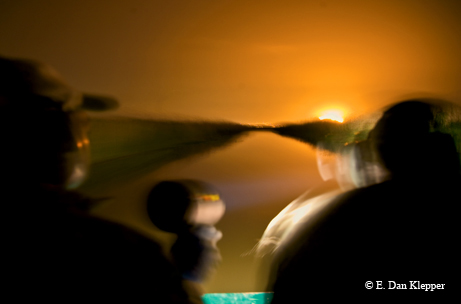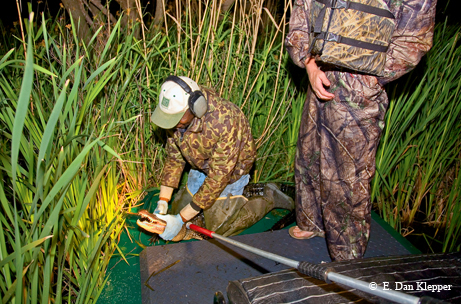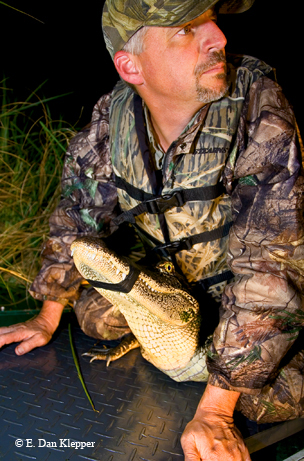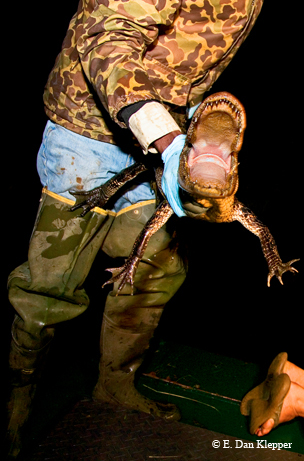
Bayou Beasts
Alligators survive and thrive in Texas wetlands.
By E. Dan Klepper
Fog trails the dark waters of Big Hill Bayou, rising in banderoles of smoke before dissipating against the bow of the small airboat. Petrochemical flare stacks ignite the horizon, casting a soiled glow across the cattails thriving in the shallows. Biologist Amos Cooper sweeps the wetland night with a high, bright spotlight. Two red embers pop to the surface, then blink, along the water’s edge. Cooper fixes the beam on them as fellow biologist Monique Slaughter maneuvers the airboat slowly forward. Biochemist Mark Merchant, outfitted head-to-toe in camo except for the black flip-flops on his bare feet, readies the pole snare.
We’re almost on top of the red eye shine when Merchant thrusts the pole forward. The snare, a collapsible noose threaded through a hollow metal rod at one end and controlled by hand at the other, is designed to live-catch and control wildlife of all kinds. It appears to be a relatively powerful tool, solid and sturdy, until Merchant snags the 6-foot alligator and swings it around to my balancing spot at the edge of the tiny foredeck.

The capture drives the swamp thing into a rage, and it snaps its jaws open in a struggle against the squeeze of the noose. The alligator flings strings of wet algae off its tail scutes as it battles with frightening strength in the wrestling match unfolding at my feet.
This is the moment my confidence in the pole snare’s integrity falters. In the bayou’s odd dimmet, a light cast by an urban and industrial night, the pole seems to turn into a fragile thing, flimsy and ill-considered, and unfortunately the only thing standing between me and a bloody thrashing of prehistoric proportions.
I shove my camera forward, a defensive measure far more than a creative one, and squeeze the shutter.
——————–—————————————————
The American alligator (Alligator mississippiensis) occupies the order Crocodylia with 22 other species including crocodiles, caimans and the gharial (one of the most endangered animals on earth). The name “alligator” comes from the Spanish el lagarto, or lizard, a relatively benign derivation considering the alligator’s ancestry. Culled by evolution from ancient reptiles called Archosaurs, the alligator has prehistoric relatives that include the Sarcosuchus, a 10-ton brute that, fully grown, exceeded the length of a city bus, and the Deinosuchus, an 8.5-ton monster of formidable jaw strength.
Bite marks of the Deinosuchus have been detected on the fossil remains of its dinosaur cousin Tyrannosaurus, evidence that may crown this alligator’s relative the king of the Cretaceous jungle. The Deinosuchus eventually disappeared, along with many other post-Archosaurs, dead-ending on the branches of the phylogenic family tree. However, the Crocodylia branch continued, gaining one very important advantage over its dinosaur cousins and other relatives — it survived the Cretaceous-Tertiary extinction event, a catastrophic meteorite collision 65 million years ago that contributed to the collapse of dinosaur populations. Since then, evolution has kept the transformation of Crocodylia to a minimum, changing very little about the alligator over the course of millions of years.

So what has kept our alligator species alive and unchanged for such a long time? It’s a question that interests Merchant, biochemistry professor at McNeese State University in Lake Charles, La. He and Cooper remove the snare and subdue the alligator with a few professional wrestling holds, and he extracts a blood sample from the base of the alligator’s skull.
Alligators may have survived and thrived, in part, because of their remarkable immune system. Serum studies have shown that antibacterial agents in alligator blood far surpass those of most other animals. Merchant and his lab assistants have isolated a specific protein from alligator blood cells that contains extremely potent and broad-acting antimicrobial properties. The results could end up providing an entirely new class of effective antibiotics for human ailments.

Once Merchant has secured the blood samples and stored them in the open hold of the little airboat, he assists Cooper and Slaughter with their own data gathering. Cooper operates the Texas Parks and Wildlife Department’s alligator program based out of the J.D. Murphree Wildlife Management Area; Slaughter operated the program with him and retired from TPWD in 2011. Murphree WMA is located along the coastal outskirts of Port Arthur and provides convenient access to the alligator-rich waters of the southeastern Texas wetlands. In addition to documenting information on alligators, TPWD biologists oversee state alligator farming, wild alligator harvesting, nuisance calls and education. Field research includes population counts, nest surveys and gathering of data for a long-term growth study.
Tonight Cooper and Slaughter are working on the long-term growth study by capturing, marking and releasing as many alligators as possible. Captured alligators are first checked for the presence of a pit tag, an electronic tracking device that indicates previous capture. A handheld scanner is used to detect the tag, providing a readout for Slaughter to record.
Untagged alligators receive their own tag. Cooper loads the tag, a small silver capsule, into a large syringe and then injects it somewhere along the alligator’s softer regions. Body measurements come next, including the full length of the alligator bellyside, as well as the tail. Gender determination and weighing follow. Notches are cut along specific scutes (bony plates) of the tail to help identify the animal and mark the capture year.
Alligators tend to resist just about all stages of this process, so Cooper and Merchant stay busy roughhousing with jaws, claws and body-slamming tails while trying to complete the tagging and examination. Slaughter, in what I judge to be the smartest move of the evening, handles the clipboard and pencil.
The American alligator is an indigenous species exclusive to the southeastern United States. It once prevailed as far north as New Jersey and west all the way to the 100th meridian in Texas (the easternmost border between the Panhandle and Oklahoma). It is a formidable apex predator, dominating wetlands from Texas to Florida.
It is also a lucky one. Indiscriminate hunting throughout its range in every Southern state thrust the alligator population to the edge of collapse by the 1960s, requiring federal intervention to save it from extinction.
The Endangered Species Preservation Act of 1966, a precursor to the act we recognize today, listed the alligator (along with six other reptiles) for protection among a selection of 78 species. Although the act initially provided protection for species on federal lands only, later amendments addressed loopholes, including regulating a commercial trade of animal parts, an issue directly affecting the alligator’s decline.
By 1969, Texas enacted its own regulations protecting the alligator and, together with federal protection, managed to revive its alligator population statewide. Today, the alligator stands as a success story in the battle for endangered species survival. It provides a concise argument for state and federal cooperation in conservation efforts, particularly when the hunter, the naturalist, industry, the environment and the animal all stand to benefit.

Beyond its obvious prehistoric charm, the alligator is an interesting biological machine featuring significant survival advantages over other animals. Unlike most reptiles, alligators have four-chambered hearts like humans, enabling a more efficient oxygen exchange in the blood, thus providing better respiration and an ability to swim continuously for long spans of time.
The tail, an extremely powerful muscle that accounts for about half the body size, acts as both navigator and propeller. With some assistance from front and back feet, the tail drives the alligator through underwater vegetation and silently along the water line and, when necessary, catapults the alligator above the water’s surface.
At the jaw end, the alligator maintains a set of up to about 80 teeth, all of which are replaced when lost, meaning the alligator will grow several thousand teeth in a lifetime. The bite force of the average alligator jaw has been measured to exert around 2,000 pounds of pressure. By way of comparison, a human’s average bite force equals around 170 pounds.
In addition to its physical survival characteristics, alligators may have a genetic advantage as well — no sex chromosomes. Alligator gender is determined by temperatures in the nest; highs produce males, lows produce females, and the middle ground produces both (although we’re still not sure how temperature-determined sex really works). Temperature variations between nests, and within each nest as well, guarantee an annual population of both males and females.
The alligator’s cold-blooded metabolism has also aided in its long-term survival. Humans and other mammals require a fixed rate of energy to survive, meaning that we must eat a certain amount every day or die. Alligators eat, grow and burn calories when the weather’s warm and food is plentiful, then reduce activity to a minimum for months at a time if temperatures turn cold and food supplies are short.
For an animal that tends to reach sizable proportions, the ability to control its metabolism is an important feature. On average, full-grown females can reach up to 9 feet in length and males up to 14 feet, weighing in at close to a thousand pounds.
The alligator is the ideal locavore, an indiscriminate eater that dines locally on just about whatever makes a meal: insects, fish, frogs, snakes, turtles, birds, small mammals, other alligators, feral hogs, even carrion. But do they eat humans? Rarely, although you should definitely use extreme caution when in alligator territory. Alligators can be aggressive if provoked and have, on occasion, taken a bite out of humans, especially if an alligator is accustomed to being fed. However, in the past 26 years only 15 serious alligator/human “encounters” have been recorded in Texas. Most importantly, no alligator-related deaths have ever been documented in the state.
It’s a fact that I find difficult to keep at the forefront of my thoughts while I try to settle into my new position on deck, straddling the open hold of the tiny airboat. I’ve moved here, just behind the single airboat seat, because it’s the only remaining unoccupied space on board.
The ongoing alligator rumble dominates the entire foredeck where I had been tenuously balanced before and is now, in fact, spilling over the sides. Cooper is strong-arming the alligator’s gyrating head, its jaws secured with a few strips of black electric tape, and Merchant has managed to straddle the back end while dodging tail slaps. Slaughter, in another smart move, occupies the captain’s chair, a perch mounted above the fray, where she has been piloting the boat.
Just below me, in the shallow hold, several alligators tolerate their captivity zipped up in canvas bags. Slaughter intends to bring them back with her to participate in an alligator awareness day for Houston Boy Scouts, part of her public education program designed to help Texans learn about alligators and their importance in our natural ecosystem. I admire her efforts, but mostly I just avoid glancing down at the moving bags and hope the canvas holds.
Back at the foredeck, the data collecting is complete. Merchant loops a nylon rope through the underside of the electric tape holding the alligator’s jaws together and takes hold of the rope ends. In one great heave-ho, Cooper and Merchant hoist the alligator over the side and into the shallow bayou. The rope pulls the electric tape away and releases the alligator’s jaws.
Not grateful in the least, our captive, now free, makes one final gnashing of teeth. As Slaughter guns the engine I hear Cooper shout, “Let’s go catch another big one!” Gathering my wits, I grab hold of the bench rail for balance, and then watch our former captive swim casually away into the night.
Related stories
Are Alligators Causing Decline of Mottled Ducks?

